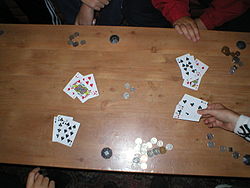Tonk (card game)
 |
|
| Origin | United States |
|---|---|
| Alternative names | Tunk or Knot |
| Type | Matching |
| Players | 2-6 |
| Skills required | Strategy |
| Cards | 52 |
| Deck | Anglo-American |
| Play | Clockwise |
| Card rank (highest to lowest) | K Q J 10 9 8 7 6 5 4 3 2 A |
| Playing time | 15 min per hand. |
| Random chance | Medium |
| Related games | |
| Conquian | |
Tonk, or tunk, is a matching card game, which combines features of knock rummy and conquian. Tonk is a relatively fast game that can be played during brief periods of time by varying numbers of players. In some places it is a popular pastime for workers on their lunch break.
Tonk is usually played for money, with a stake agreed on before the game starts. Each player pays the stake to the winner of the hand. Games typically involve three to five players. Stakes may be any amount. A game consists of several hands. The players take turns dealing.
A standard fifty-two card deck is used. Each card has a point value: Ace through ten have their face value, aces having a value of one point, deuces a value of two points, and so on. The Jack, Queen, and King are each worth ten points.
Players are dealt three, five, seven, or twelve cards, depending on the number of players, in turn. The dealer turns up the first of the un-dealt cards as the start of the discard pile. (Some people play that the dealer does not turn up the first card. The discard pile is started after the first player draws.) The remaining un-dealt cards are set face down in a stack next to the discard pile. These form the stock.
Players total up the points in their hand. If a player has 50 points (or 49 in some variations) he says, "tonk" and immediately wins a double stake from each player. If two players have 50 points the hand is a draw, and another hand is dealt. Some people play that a dealt hand of 11 or lower is also a tonk. In the case where two players are dealt tonk, then a 50 would beat a 49, 11 would beat 50, 10 would beat 11, 9 would beat 10 and so on. If no one tonks, play continues. The player to the left of the dealer begins, and play continues in turn.
The goal of play is to get rid of one's cards by forming them into spreads. A spread is three or four identical cards regardless of suit (such as three 5's or four Queens), or three or more in a row of the same suit. A player may add cards to his own or another's spread. The winner is the first to get rid of all his cards, or the player with the fewest points when play is stopped.
Play stops when a player gets rid of all his cards, if a player tonks and the opponent has equal amount, this leads the second player to win because it is called being "caught" or when a player drops, by laying his cards face up on the table. A player may drop at any point in the game (some play you can only drop before drawing), including right after the cards are dealt. When a player drops, all the players likewise lay their cards face up. The player with the fewest points in his hand is the winner. If the player who dropped does not have the fewest points, he must pay the stake to each player with fewer points. This is called being caught. In addition, each player pays the stake to the winner. If there is a tie, both players are paid. If the tie is between the player who dropped and another player, the one who dropped is considered caught and must pay double, with the other player being the sole winner.
...
Wikipedia
